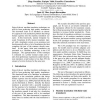Free Online Productivity Tools
i2Speak
i2Symbol
i2OCR
iTex2Img
iWeb2Print
iWeb2Shot
i2Type
iPdf2Split
iPdf2Merge
i2Bopomofo
i2Arabic
i2Style
i2Image
i2PDF
iLatex2Rtf
Sci2ools
EMNLP
2004
2004
From Machine Translation to Computer Assisted Translation using Finite-State Models
State-of-the-art machine translation techniques are still far from producing high quality translations. This drawback leads us to introduce an alternative approach to the translation problem that brings human expertise into the machine translation scenario. In this framework, namely Computer Assisted Translation (CAT), human translators interact with a translation system, as an assistance tool, that dinamically offers, a list of translations that best completes the part of the sentence already translated. In this paper, finite state transducers are presented as a candidate technology in the CAT paradigm. The appropriateness of this technique is evaluated on a printer manual corpus and results from preliminary experiments confirm that human translators would reduce to less than 25% the amount of work to be done for the same task.
EMNLP 2004 | EMNLP 2007 | Human Translators | Machine Translation | State-of-the-art Machine Translation |
| Added | 30 Oct 2010 |
| Updated | 30 Oct 2010 |
| Type | Conference |
| Year | 2004 |
| Where | EMNLP |
| Authors | Jorge Civera, Elsa Cubel, Antonio L. Lagarda, David Picó, Jorge González, Enrique Vidal, Francisco Casacuberta, Juan Miguel Vilar, Sergio Barrachina |
Comments (0)

